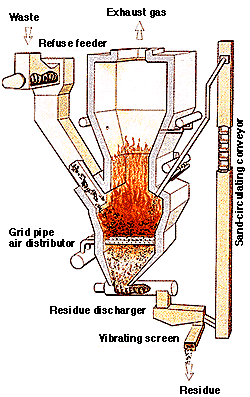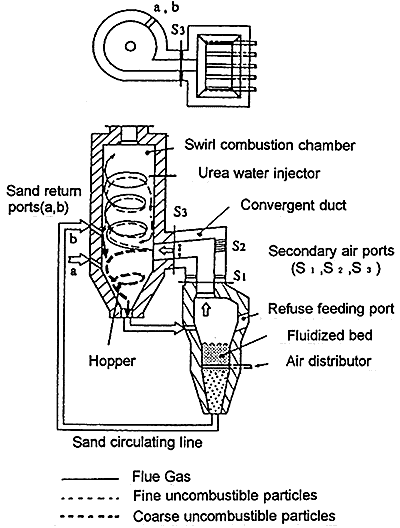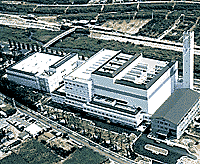Waste Treatment Technology in JAPAN
Drying, Incineration and Melting
IHl's extensive furnace technology has been applied to perfect a waste incineration plant that employs a fluidized bed incinerator. The plant resolves the primary problem of waste disposal while also solving the secondary problem of pollution by flue gas, odor, noise and residue disposal, and converting the incineration-generated heat into useful thermal energy.
Fig.1 Construction of IHI Fluidized bed Incinerator
1) Principle of dioxin control
(b) High-calorie waste
Waste which contains a large amount of plastic and rubber
materials and other high-calorie substances can be easily
burned.
1. Construction and mechanism of IHI fluidized bed incinerator (Fig.1)
1) Construction
IHI fluidized bed incinerator has grid pipe air distribution system. Residue iS discharged effectively by a forced discharging system. Incombustibles and dust completely separated in dry condition, are discharged from the incinerator.
2) Incineration system
Heated sand is agitated rigorously in the fluidized bed to disperse the charged waste evenly so that it is heated from all sides. The waste is dried, ignited and burned almost instantaneously to achieve complete incineration. The residue contains incombustibles only and is free of any other unburned waste. Uniform combustion performance of the incinerator ensures the maintenance of stable and complete waste incineration.

2. Advanced new type incinerator (Fig.2)
IHI has developed an advanced swirl combustion fluiduzed bed incinerator for dioxin control during municipal waste disposal.
The primary requisite for preventing dioxin emission is to burn the waste completely while it is still in the furnace. Less apparent though equally important is the need to optimize both the furnace design and combustion method so as to reduce the amount of unburnt matter, typically char, which requires a longer combustion period.
2) Construction of the advanced incinerator
The incinerator employs a secondary combustion swirl chamber to incinerate unburned combustibles from the initial burning. The combustibles are carried into the secondary chamber by bed material.
Fig.2 Geometry of Swirl Combustion Fluidized bed Incinerator

3. Features
1) Capability of incinerating all kind of wastes
Any type of waste can be completely burned and the volume of residue can therefore be minimized.
2) Damage-free incinerator
(a) Low-calorie watery waste
Raw sewage sludge that has a high water content can be burned
with supplementary fuel, or easily burned mixed with municipal
solid waste.
There are no mechanical movable parts inside the incinerator. Uniform combustion is ensured throughout the furnace and partial overheating cannot occur. The incinerator is therefore free of the corrosion or damage that is normally caused when burning plastic materials, etc.
3) Clean and dry residue
The residue contains only metals, glass, ceramics, and other incombustibles and is dry and free of harmful substances as well as heavy metal effluent. The residue contains no unburned waste and therefore will not generate odors or septic gas. No problems will be caused even if the residue is used for land-filling near a housing area.
4) Easy and trouble-free operation
The incineration can be started quickly without using oil even after a weekendshutdown and with no damage to the incineration.
4. Actual production
IHI has delivered 30plants since l977 and is constructing 5plants now for municipal waste in Japan.
5. Examples of incineration plant
1) Takakura Clean Center ( Saitama pref. Japan )
(1) Treated waste : Municipal waste
(2) Capacity : 180 ton/day ( 60t/dx3 )
(3) Low heat value of waste : 2,400 kcal/kg
(4) Operating time a day: 16h/day
2) Koufu City ( Yamanashi pref. Japan )
(1) Treated waste: Municipal waste
(2) Capacity : 360 ton/day ( 120t/dx3 )
(3) Low heat value of waste : 2,800 kcal/kg
(4) Operating time a day : 24h/day
(5) Power generation capacity: 1,950 kW
Photo.1 Koufu City Incineration Plant
